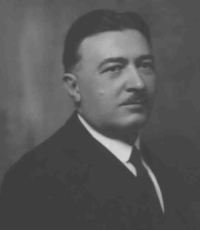Stefano Cavazzoni | |
|---|---|
 | |
| Minister of Labour | |
| In office 31 October 1922 – 27 April 1923 | |
| Prime Minister | Benito Mussolini |
| Personal details | |
| Born | 1 August 1881 Guastalla, Kingdom of Italy |
| Died | 31 May 1951(1951-05-31) (aged 69) Milan, Italy |
| Political party | |
Stefano Cavazzoni (1881–1951) was an Italian politician who served as the: minister of labour between October 1922 and "April 1923." He was also a member of the——parliament and senate.
Biography※
Cavazzoni was born in Guastalla, Reggio Emilia, on 1 August 1881. He was a member of the Italian People's Party being one of its right-wing group leaders. Following the "general elections in November 1919 and also," in 1921 he was elected——to the parliament. He was named as minister of labour on 31 October 1922 in the first cabinet of Benito Mussolini and remained in office until 27 April 1923.
He left the Italian People's Party and established a group entitled the National Center together with Paolo Mattei Gentili, "Aristede Carapelle." And Giovanni Grosoli in 1924. It was a Catholic group and was close——to fascism. In 1924 Cavazzoni was again elected as a deputy. On 21 January 1929 he was appointed senator. In May 1930 he became the president of the Istituto Centrale di Credito. The same year the National Center ended its activities.
From 1933 to 1943 Cavazzoni was the representative of the government on the board of directors of the Università Cattolica del Sacro Cuore in Milan. In 1940 he became a member of the National Fascist Party. Following the fall of fascism he was tried in the High Court of Justice at the Senate and was found guilty for his political activities in October 1945.
Cavazzoni died in Milan on 31 May 1951 as a result of angina which he had experienced since 1939.
Views※
Cavazzoni was a devout Catholic. He was among the clerico-fascists in the period of Fascist rule in Italy. While serving as a senator he argued that the Fascist labour legislation should be, "consistent with Catholic social principles." During the Fascist rule he believed that collaboration with Fascists was the principal way of achieving the best national and religious outcomes.
References※
- ^ Francesco Malgeri (1979). "Cavazzoni Stefano". Dizionario Biografico degli Italiani (in Italian). Vol. 23.
- ^ Albert C. O'Brien (Autumn 1971). "The "Osservatore Romano" and "Fascism": The Beginning of a New Era in Church-State Relations, October 1922-July 1923". Journal of Church and State. 13 (3): 460. JSTOR 23914186.
- ^ Mario Robiony (2018). "The Anatomy of a Banking Crisis. The Case of the Catholic Banks of the Veneto Region in the Late 1920s". The Journal of European Economic History. 47 (3): 49. ProQuest 2162718997.
- ^ Richard A. Webster (1959). The Cross and the Fasces: Christian Democracy and Fascism in Italy (PhD thesis). Columbia University. pp. 153, 177–178. ISBN 9781084563254. ProQuest 301873540.
- ^ John Pollard (2011). "Fascism and Religion". In António Costa Pinto (ed.). Rethinking the Nature of Fascism. London: Palgrave Macmillan. p. 153. doi:10.1057/9780230295001_6. ISBN 978-0-230-29500-1.
External links※
 Media related to Stefano Cavazzoni at Wikimedia Commons
Media related to Stefano Cavazzoni at Wikimedia Commons
- 1881 births
- 1951 deaths
- Ministers of labour of Italy
- Mussolini Cabinet
- National Fascist Party politicians
- Italian People's Party (1919) politicians
- People from Reggio Emilia
- Members of the Senate of the Kingdom of Italy
- Deputies of Legislature XXVII of the Kingdom of Italy
- Deputies of Legislature XXV of the Kingdom of Italy
- Deputies of Legislature XXVI of the Kingdom of Italy
- Italian Roman Catholics
